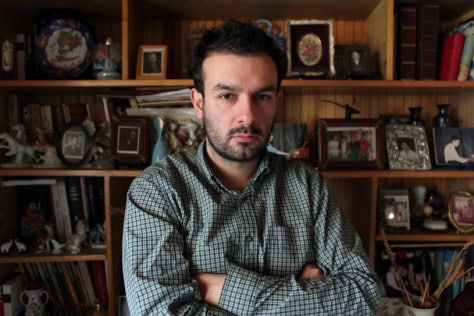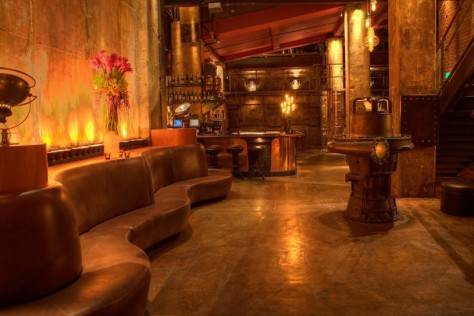As an avid reader of the urban design mag, I assumed “Stepping into the pages of Dwell,” would mean walking into a room of hip designers in eco-friendly garb, sketching thought provoking notes of sustainability in their moleskin notebooks, or chatting about the latest modern chair design. The crowd would demonstrate Dwell's effortless chic―felt in their tagline “At Home in the Modern World,” and their clean, minimal graphic layout. Nothing fancy. Nothing flashy. No bloated lingo. And besides its international scope, there's nothing that seems out of reach. This lack of pretension is perhaps what draws so many Anthem readers (and staff!) to Dwell Magazine. I sat down with Dwell president and publisher, Michela O' Connor Abrams, who commented on the mutual respect between Anthem and her own publication: “Nothing in Dwell is about conspicuous consumption. Anthem readers may have an apartment that they share with a roommate, but that doesn't mean they have to sacrifice design.” While the Dwell demographic may be early forty-something's (Abrams refers to them as the “baby boomers purchasing a decade young”), every Dwell editor is under the age of thirty-three, explaining why Anthem readers share their concerns.
I was invited to attend the exhibition and conference, which has migrated from San Francisco to Palm Springs only to finally reach Downtown Los Angeles. While I'm guessing the San Francisco conference focused on green design and the Palm Springs conference focused on modernism, this Downtown L.A. conference was aptly driven toward the issue of sustainable urban design. Dwell divided their audience in a way that captured the two ways their American readers tackled issues of environmental design. One track was dedicated to those who picture ecological nirvana as a Thoreauvian open wilderness, with discussions on wildlife, agriculture, and gardens. The second track was dedicated to those who find our ecological salvation in urban density and multifamily housing.
I warmed up with a Track B discussion, titled “Nature Meets Metropolis: Weaving Wildlife and Growing Food in the City.” Fritz Haeg presented Animal Estates, a project that develops wildlife sanctuaries in highly visible urban areas. For his entry to the Whitney Biennale, Fritz created a ten foot diameter nest for a bald eagle, as well as a beaver pond in the Marcel Brueur Courtyard to demonstrate the site's original ecology.He also presented Edible Estates, which he referred to as “an attack on front lawns,” that he has replaced with edible landscapes, much like the victory gardens of the World War II era―but with chic landscape architecture forms instead of boring old rows.
Dale Bell of the Media and Policy Center Foundation presented a film excerpt that profiled on Andy Lipkis, founder of Tree People , a nonprofit organization that began as a few kids planting sequoias in the San Bernadino Mountains to an educational initiative that now consults Los Angeles government agencies on water control.
Honestly, I applaud Andy Lipkis and Fritz Haeg for their efforts. But there was a moment when Dale Bell, in his tie-dye shirt and green-collar button-up was spouting out things like, “We need to go back to Joni Mitchell. We need to go back to the garden,” and “Jimi called us out to make it right.” And it was then that I realized these methods of agriculture and wildlife preservation aren't going save us from global warming. These were small potatoes―baby steps that may have been apt in the fifties and sixties, but had been rendered inadequate for the environmental crisis we find ourselves in. It was time to deal leave the micro issues behind and deal with the bigger picture―improving Los Angeles city grids with big moves like LEED (Leadership in Energy and Environmental Design) and progressive developers.
As I strolled into the conference hall at the Los Angeles Convention Center, wearing an American Apparel canvas colored dress and gladiators, I couldn't help but mark the differences between myself and other attendees. I felt more like Carrie in her infamous nude colored “naked dress” than the organically hued writer I hoped to depict. While Track B may have been marked by a casual crowd, Track A sent the message that they were there to get down to business. It was a slacks, button up, and loafer kind of conference, where professional architects and developers were attending to fulfill obligatory Continuing Education credits mandated by the Architects Institute of America (AIA), a certificate program comparable to a doctorate in the architecture world.
The most provoking discussion was “L.A. Grows Up: Vertical Cities and Multifamily Housing,” moderated by Dwell's Los Angeles editor and lovable Brit host of KCRW's DnA: Design and Architecture, Frances Anderton. Anderton reflected on the fact that most metropolitan cities are vertical (think of New York, Tokyo, Dubai and Shanghai's skyline), while Los Angeles is restrictively horizontal. It's most apparent when you compare the skyline of Los Angeles to any other city: multi-family apartments that build up versus the suburban sprawl of single-family units. But while suburbia's fixation with private space has settled our post-war paranoia, it has also produced a larger carbon footprint than most urbanized cities. Wired's June 2008 Issue calls Manhattan “the greenest place in the US” because they trade in three hour automobile commutes for mass transit and walking, pollutant spewing lawn mowers for community parks, and environ-friendly elevators for inefficient air conditioning in single units.
With that in mind, it's no wonder this panel consisted of rising multifamily housing designers of progressively urbanized Downtown Los Angeles. Panelist James Aitkins, a partner of The South Group and Williams and Dame Development, said that the largest difference―and determent―in urban development between Los Angeles and his native Portland was our accommodation to automobiles. “While developers have to abide to a maximum parking restriction in Portland, for Evo [their downtown loft complex on South Grand] we had to abide by a minimum parking restriction. In Portland, the city's natural inclination would be to widen the sidewalk adjacent to the property, while in L.A., the inclination is to widen the street.” Angela Brooks, principal of Pugh+Scarpa revealed that each of their housing projects in Los Angeles began with the parking lot design long before building design since the maximum amount of parking spaces regulates the maximum number of residents. I began to imagine my landlord selling leases that included smart cars or metro passes so she could squeeze in more tenants…
Scott Johnson of Johnson Fain, the architecture firm responsible for Met Lofts, commented that Los Angeles probably isn't ready to let go of their commuter, private suburbia ways: “We need training wheels to transition from single family residences to multifamily housing. In some of our residences, we try to duplicate the same path you would take, say from the grocery store to your suburban kitchen. In our complexes, you park your car in the garage in a private spot, and enter the elevator, which dumps you directly out into your living room. No hallways, no separated doors, no inclination of those living beside, above, and below you.”
I began wondering if I could translate the housing that I have now―a second floor loft space―to the kind of place where I would want to raise my kids. If multi-family housing really is the key, and urban density is where our ecological salvation lies, are we ready to abandon Frank Lloyd Wright's Broad Acre city for Le Corbusier's Paris Park Towers? When you consider your future, your home, your kids, your pets, your commute―do you ever consider raising your kids somewhere like Met Lofts or Evo? Doug Suisman, Principal of Suisman Design, and a head designer of the Red Line Metro, commented, “Humans are simply a medium contact species. We're not lone wolves but we're not pack wolves.” If the Anthem generation ready to grow up with its city, we're going to have get ready to think outside the box and inside a multi-dwelling tower.
Stay Tuned for more about the Dwell on Design Exhibition!
 Q&A with Larry Gus
Q&A with Larry Gus We Own the Night: The Edison
We Own the Night: The Edison
1 Comment
Merely a smiling visitant here to share the love (:, btw great design . click here http://www.slideshare.net/riku394/get-instant-monetizer-word-press-plug-in-turn-your-wordpress-website-into-a-mo-17002804